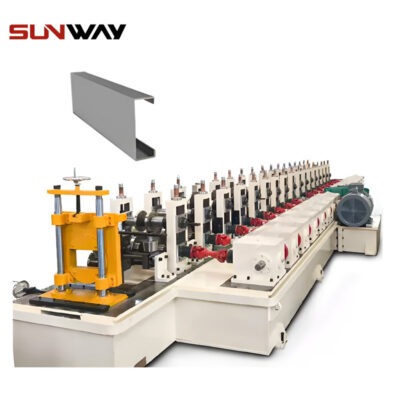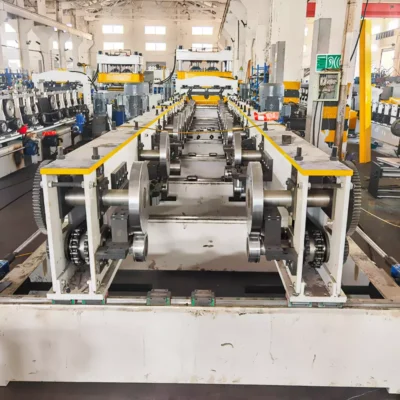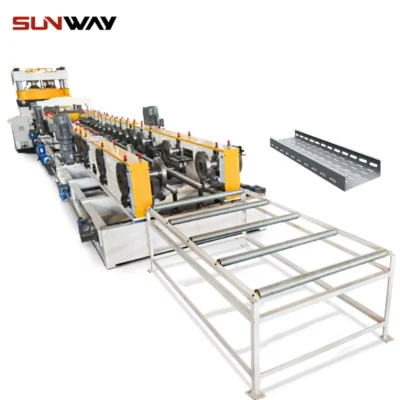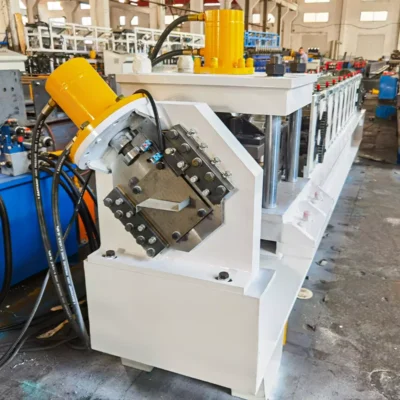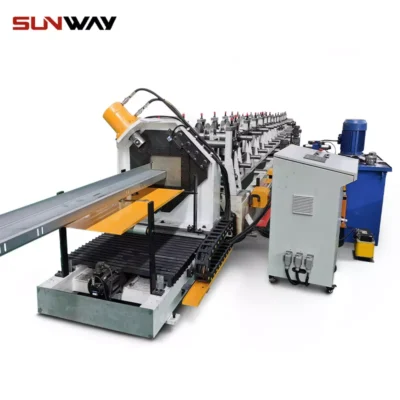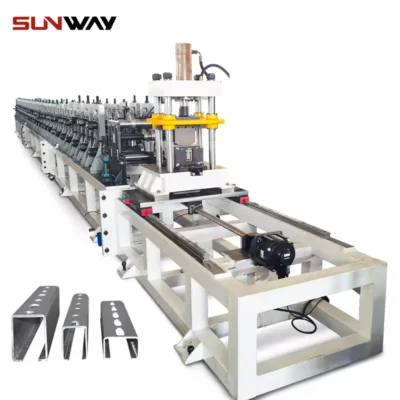In our increasingly connected world, antenna towers serve as the backbone of telecommunication networks, enabling seamless communication across continents. With the rise of 5G technology and the expansion of rural connectivity goals, the demand for robust, lightweight, and cost-effective antenna towers has never been higher. Antenna Tower Roll Forming Machines are at the forefront of this revolution, allowing manufacturers to produce precision-engineered components for antenna towers with incredible speed and efficiency.
This article explores the Antenna Tower Roll Forming Machine, detailing its applications, design innovations, pricing, and how Wuxi Sunway Machinery is leading the way in roll-forming technology. Whether you’re in telecommunication infrastructure manufacturing or a supplier of industrial-grade towers, this guide will equip you with all the knowledge you need.
What is an Antenna Tower Roll Forming Machine?
एक Antenna Tower Roll Forming Machine is specialized industrial equipment designed for the production of structural components used in antenna towers. These machines take raw materials, such as metal coils, and shape them into precision-made profiles like angles, channels, and tubes—essential parts of an antenna tower’s framework.
The roll-forming process is a continuous, automated method that ensures uniformity, durability, and cost-efficiency in component production. From lightweight towers for urban 5G networks to heavy-duty towers for rural and industrial applications, these machines enable manufacturers to meet the demand for high-quality infrastructure.
Applications of Antenna Tower Roll Forming Machines
Antenna towers are a critical component of telecommunication networks, broadcasting systems, and emergency communication setups. Here are the primary applications of components produced by roll-forming machines:
1. Telecommunication Towers
- Use Case: Towers supporting cellular networks, including 4G, 5G, and beyond.
- Why It Matters: Roll-formed components ensure the lightweight yet sturdy profiles required for urban and rural telecommunication infrastructure.
2. Broadcast Towers
- Use Case: Towers for radio, television, and satellite broadcasting.
- Why It Matters: Roll-formed components provide the rigidity and corrosion resistance necessary for long-term outdoor use.
3. Emergency Communication Systems
- Use Case: Towers for emergency response teams, military communication, and disaster recovery networks.
- Why It Matters: High-strength roll-formed profiles can withstand harsh conditions, ensuring reliable performance when it matters most.
4. Wind Measurement Towers
- Use Case: Towers equipped with anemometers and sensors for wind farm feasibility studies.
- Why It Matters: Lightweight roll-formed profiles make these towers easier to install and dismantle.
5. Rural and Remote Connectivity
- Use Case: Towers used to expand internet and mobile connectivity to underserved areas.
- Why It Matters: Roll-forming machines enable cost-effective production of components, making rural projects economically viable.
6. Surveillance and Security Towers
- Use Case: Towers for mounting cameras, sensors, and monitoring equipment in security systems.
- Why It Matters: Roll-formed components ensure stable, durable structures capable of supporting heavy surveillance equipment.
Key Features of Wuxi Sunway Antenna Tower Roll Forming Machines
When it comes to manufacturing antenna tower components, Wuxi Sunway Machinery offers cutting-edge roll-forming machines that deliver precision, efficiency, and customization. Here’s why their machines are trusted worldwide:
1. Multi-Profile Capability
- What It Offers: Machines can produce various profiles, such as L-angles, U-channels, and square tubes.
- Why It’s Revolutionary: Supports diverse antenna tower designs, from compact urban towers to large-scale rural installations.
2. Material Versatility
- Supported Materials:
- Galvanized steel
- Stainless steel
- High-strength aluminum alloys
- Weathering steel (Corten steel)
- Why It Matters: Enables the production of components that are lightweight, durable, and corrosion-resistant.
3. Precision Engineering
- What It Does: Produces components with tight tolerances and smooth finishes.
- Why It’s Important: Ensures perfect assembly and alignment, reducing installation time and improving structural integrity.
4. Integrated Punching and Cutting Systems
- Features: Servo-controlled punching units create holes and slots, while cutting systems trim components to exact lengths.
- Why It Matters: Eliminates secondary operations, saving time and costs.
5. High-Speed Production
- Performance: Capable of producing up to 15 meters of profiles per minute, depending on the complexity of the design.
- Why It Matters: Meets the high-volume demands of antenna tower manufacturers.
6. Automation with PLC Control
- Features:
- Fully automated operations with programmable logic controllers (PLC).
- Intuitive touchscreen interface for easy operation.
- Real-time monitoring and diagnostics.
- Why It’s Revolutionary: Reduces reliance on skilled labor while ensuring consistent quality.
7. Modular and Compact Design
- What It Includes: Machines are designed to integrate seamlessly into existing production lines.
- Why It Matters: Optimizes factory floor space while providing flexibility for future upgrades.
8. Eco-Friendly Operation
- What It Offers: Energy-efficient motors and waste-reducing technologies.
- Why It Matters: Supports sustainable manufacturing practices, minimizing environmental impact.

Production Workflow of an Antenna Tower Roll Forming Machine
The production process for antenna tower components is optimized for speed and precision. Below is a step-by-step overview:
1. Decoiling
- Raw metal coils are loaded onto the decoiler, which feeds the material into the machine.
2. Leveling
- A leveling system ensures the material is flat and free from warping or defects before entering the roll-forming section.
3. Roll Forming
- The material is progressively shaped through a series of rollers into the desired profile, such as an L-angle or U-channel.
4. Punching and Cutting
- Integrated punching units create holes for bolts or other fasteners, while cutting systems trim the components to the required lengths.
5. Surface Treatment
- Optional surface treatments, such as galvanization or powder coating, enhance corrosion resistance and aesthetics.
6. Stacking
- Finished components are automatically stacked for packaging and transportation.
Pricing of Antenna Tower Roll Forming Machines
The cost of an Antenna Tower Roll Forming Machine varies depending on its features, production capacity, and customization options. Below is a general pricing guide for 2025:
| Machine Type | Capabilities | Price Range (USD) |
|---|---|---|
| Standard Machines | Basic profile production | $150,000–$250,000 |
| High-Precision Machines | Advanced tolerances and multi-profile output | $250,000–$450,000 |
| Fully Customizable Machines | Multi-material compatibility and features | $450,000–$700,000 |
For detailed pricing and financing options, contact Wuxi Sunway Machinery.
Advantages of Using Antenna Tower Roll Forming Machines
Investing in a Wuxi Sunway Antenna Tower Roll Forming Machine offers significant advantages for manufacturers:
1. High Production Efficiency
- High-speed production reduces lead times and increases output.
2. Precision and Consistency
- Ensures uniform quality across all components, minimizing assembly errors.
3. Material Flexibility
- Supports a wide range of materials, including corrosion-resistant alloys.
4. Cost Savings
- Reduces material waste and labor costs, improving overall profitability.
5. Scalability
- Suitable for both small-scale manufacturers and large-scale production lines.
FAQs About Antenna Tower Roll Forming Machines
| Question | Answer |
|---|---|
| What is the production capacity? | Machines can produce up to 15 meters of profiles per minute, depending on the design. |
| Can the machine process weathering steel? | Yes, it is compatible with materials like Corten steel, ideal for outdoor applications. |
| What is the typical lead time for delivery? | Delivery takes 3–6 months, depending on customization requirements. |
| Does Sunway provide after-sales support? | Absolutely! Wuxi Sunway offers training, maintenance, and troubleshooting services. |
| What is the expected lifespan of the machine? | With proper maintenance, the machine can last 10–15 years or more. |
| Can the machine produce custom profiles? | Yes, it supports multi-profile capabilities for customized antenna tower designs. |
Global Trends Driving the Adoption of Antenna Tower Roll Forming Machines
The antenna tower industry is experiencing a transformation fueled by technological advancements, sustainability goals, and growing connectivity needs. Here are the major trends shaping the demand for Antenna Tower Roll Forming Machines in 2025:
1. Expansion of 5G Networks
- The Trend: Global 5G network deployments are accelerating, with millions of towers needed to support high-speed, low-latency connectivity.
- Impact on Tower Manufacturing: 5G towers require lightweight, customizable components to fit urban environments and reduce installation complexity.
- Why It Matters: Roll-forming machines enable manufacturers to produce precise, modular components that meet 5G network demands.
2. Rural Internet Connectivity Initiatives
- The Push: Governments and organizations are working to bridge the digital divide by expanding broadband access to underserved rural areas.
- Impact on Tower Manufacturing: Rural towers must be cost-effective, durable, and easy to transport and assemble.
- Why It’s Exciting: Roll-forming machines streamline the production of sturdy, corrosion-resistant components suitable for remote installations.
3. Climate-Resilient Infrastructure
- The Need: Climate change is prompting the design of towers capable of withstanding extreme weather conditions, such as hurricanes, floods, and temperature fluctuations.
- Impact on Tower Design: Components must be fabricated from high-strength, weather-resistant materials.
- Why It’s Crucial: Roll-forming machines can process advanced materials like weathering steel, ensuring towers remain operational in harsh climates.
4. Growth of Emergency Communication Systems
- The Context: Emergency response networks rely heavily on antenna towers to maintain communication during disasters.
- Impact on Tower Production: Emergency towers must be quick to assemble, portable, and reliable under stress.
- Why It Matters: Roll-forming machines produce standardized components that can be rapidly deployed in crisis situations.
5. Sustainability and Green Manufacturing
- The Shift: Industries are prioritizing eco-friendly practices, reducing waste, and adopting recyclable materials in their production processes.
- Impact on Roll Forming: Machines are being designed with energy-efficient motors and optimized workflows to minimize environmental impact.
- Why It’s Important: Roll-forming technology aligns with sustainability goals, making it the preferred choice for environmentally conscious manufacturers.
Technological Innovations in Antenna Tower Roll Forming Machines
The advancement of Antenna Tower Roll Forming Machines is driven by cutting-edge technologies that enhance efficiency, precision, and sustainability. Let’s explore the most significant innovations shaping the future of this industry:
1. Digital Twin Technology
- What It Does: Creates a virtual replica of the roll-forming machine, simulating production processes and testing designs before implementation.
- Benefits:
- Speeds up prototyping and reduces time-to-market.
- Identifies potential issues before production, minimizing downtime.
- Enhances machine performance through continuous optimization.
2. Real-Time Production Monitoring
- The Technology: IoT-enabled sensors collect real-time data on machine performance, output quality, and material usage.
- Why It’s Revolutionary:
- Facilitates predictive maintenance, reducing unexpected breakdowns.
- Provides actionable insights to optimize workflows.
- Ensures consistent quality by monitoring production parameters in real time.
3. Advanced Welding Systems
- What It Offers: Integrated welding systems create seamless joints for hollow profiles or multi-part components.
- Why It Matters:
- Reduces weak points in the structure, enhancing durability.
- Simplifies assembly by producing ready-to-install components.
- Eliminates the need for post-production welding, saving time and costs.
4. Multi-Material Processing
- What It Supports: Machines can process a wide range of materials, including galvanized steel, aluminum alloys, and weathering steel.
- Why It’s Crucial:
- Enables manufacturers to produce towers for diverse applications, from urban 5G networks to rural connectivity projects.
- Improves compatibility with different environmental conditions.
5. Energy-Efficient Design
- The Feature: Machines are equipped with energy-saving motors and optimized production cycles.
- Why It Matters:
- Reduces electricity consumption, lowering operational costs.
- Supports manufacturers in meeting sustainability targets.
- Enhances the overall efficiency of the production process.
6. Customizable Tooling and Profiles
- What It Does: Machines offer modular tooling systems that allow for quick changes between different profiles.
- Why It’s Important:
- Provides flexibility to adapt to changing market demands.
- Reduces downtime during product transitions.
- Simplifies the production of customized tower designs.

Environmental Impact of Antenna Tower Roll Forming Machines
The telecommunication industry is under pressure to adopt eco-friendly practices, and Antenna Tower Roll Forming Machines are leading the charge. Here’s how they contribute to sustainability:
1. Minimal Material Waste
- How It Works: The roll-forming process maximizes material usage, minimizing scrap and offcuts.
- Impact: Reduces raw material consumption and production costs.
2. Recyclable Outputs
- The Advantage: Components made from materials like galvanized steel and aluminum are fully recyclable.
- Why It Matters: Promotes a circular economy and reduces landfill waste.
3. Energy Efficiency
- The Innovation: Modern machines consume less energy while maintaining high production speeds.
- Why It’s Crucial: Lowers the carbon footprint of manufacturing operations.
4. Localized Production
- What It Enables: Machines allow manufacturers to produce components locally, reducing the environmental impact of transportation.
- Outcome: Supports regional sustainability while enhancing supply chain reliability.
Comparison: Antenna Tower Roll Forming Machines vs. Traditional Methods
Let’s compare Antenna Tower Roll Forming Machines with traditional manufacturing methods, such as manual fabrication or extrusion:
| Feature | रोल बनाने की मशीन | Traditional Methods |
|---|---|---|
| Precision | High; ensures consistent dimensions | Moderate; prone to human error |
| Production Speed | High; up to 15 meters per minute | Slow; labor-intensive processes |
| Automation | Fully automated with PLC and IoT integration | Mostly manual or semi-automated |
| Material Waste | Minimal; optimized processes reduce scrap | Higher; less efficient material usage |
| Cost Efficiency | Higher initial cost, lower operational costs | Lower initial cost, higher long-term costs |
| Scalability | Ideal for high-volume production | Limited scalability for large-scale demand |
FAQs About Antenna Tower Roll Forming Machines
| Question | Answer |
|---|---|
| Can the machine produce custom profiles? | Yes, it supports multi-profile capabilities for customized tower designs. |
| What is the expected lifespan of the machine? | With proper maintenance, the machine can last 10–15 years or more. |
| Does Sunway offer installation support? | Absolutely! Sunway provides on-site installation and commissioning services. |
| What is the delivery time? | Delivery typically takes 3–6 months, depending on customization requirements. |
| Can the machine handle lightweight materials? | Yes, it can process aluminum and other lightweight alloys. |
| Is operator training included? | Yes, comprehensive training is provided with every machine purchase. |
Why Choose Wuxi Sunway Machinery for Antenna Tower Roll Forming Machines?
Here’s why Wuxi Sunway Machinery is the go-to choice for manufacturers worldwide:
- Proven Expertise: Decades of experience in delivering innovative roll-forming solutions.
- Global Reach: Trusted by clients across Asia, Europe, the Americas, and beyond.
- Customization Excellence: Machines tailored to meet specific antenna tower designs and material requirements.
- Sustainability Leadership: Eco-friendly designs that minimize waste and reduce energy usage.
- Cutting-Edge Technology: Features like IoT integration, servo-driven systems, and AI-powered quality control.
- Comprehensive Support: From installation to troubleshooting, Sunway ensures seamless operations and customer satisfaction.
Conclusion: Building the Future of Connectivity with Roll-Forming Excellence
The Antenna Tower Roll Forming Machine is revolutionizing telecommunication infrastructure by enabling the efficient production of durable, lightweight, and customizable tower components. Whether you’re expanding 5G networks, rolling out rural connectivity, or building resilient emergency communication systems, these machines deliver the precision and scalability needed to meet modern demands.
Interested in upgrading your production capabilities? Contact Wuxi Sunway Machinery today to explore their state-of-the-art roll-forming solutions. Together, let’s build the backbone of tomorrow’s connectivity—one tower at a time!




